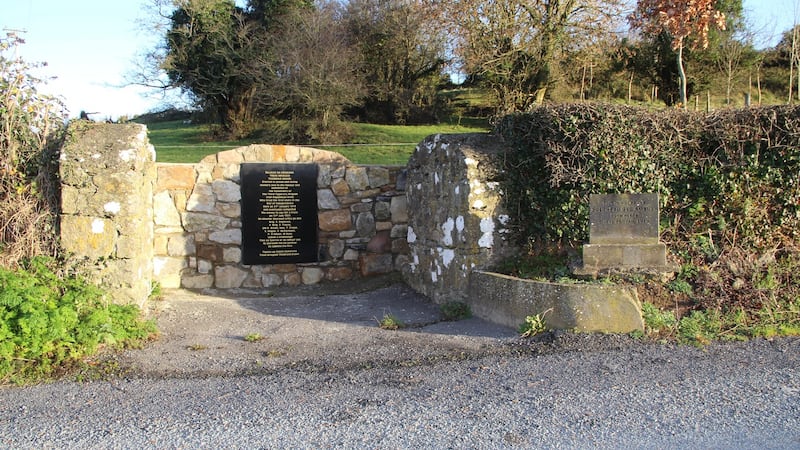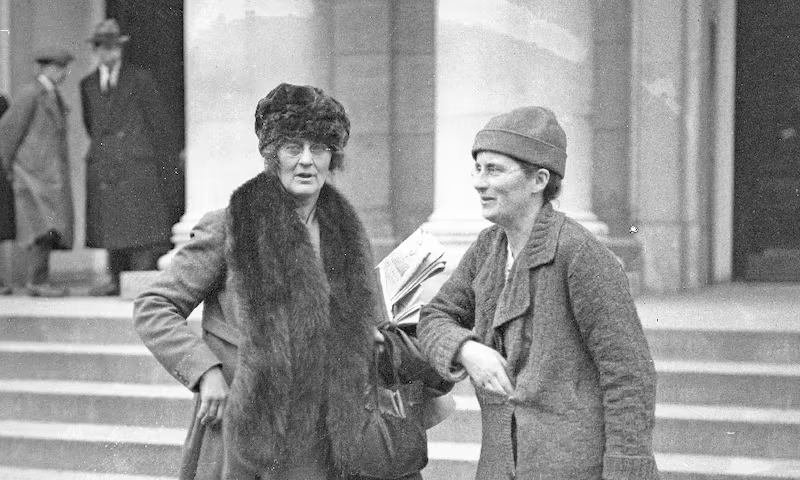In January 1950 a memorial was unveiled to those who carried out the Soloheadbeg ambush. It is situated in Solohead village outside Tipperary town surrounded by the holy trinity of rural Irish life – the pub, the Catholic Church and the GAA ground.
Its unveiling provoked a number of angry letters to The Irish Times. Even at the remove of three decades, Soloheadbeg still had the power to provoke strong emotions.
The killing of two Royal Irish Constabulary (RIC) constables, one letter writer wrote, was "an un-Christian act"; another said it was unauthorised. "Wicked" and "shameful" were two other choice epithets slung at the ambush perpetrators.


There was one letter in defence of the ambush. The anonymous author signed off as "Dalariada", the ancient Celtic name for the joint kingdoms of Ireland and Scotland.
Dalariada said the men at Soloheadbeg were acting under instruction to seize weaponry from the British authorities, in this case gelignite destined for Soloheadbeg quarry.
It was “abundantly clear”, he added, that the two policemen were shot dead after refusing to surrender and the ambushers had acted in self-defence.
The author had good reason to disguise his real identity. He was then a civil servant in charge of the Bureau of Military History which was set up in the 1940s to record the testimonies of those involved in the revolutionary period.
Dalariada was Séamus Robinson. He was the officer commanding the 3rd Tipperary Brigade of the Irish Volunteers at Soloheadbeg, not as many have assumed in the years since the better known Republican figures of Dan Breen and Seán Treacy.
Deep hatred
Robinson did not turn up at the unveiling of the Soloheadbeg memorial. According to local historian Denis Marnane's recently published 3rd Brigade: History of the Volunteers/ IRA in South Tipperary 1913-1921, Robinson and Breen so heartily detested each other that one would not turn up to a function if one knew the other was going to speak.
Breen adhered to the old Churchill dictum that history would be kind to him as he intended to write it. His autobiography, My Fight For Irish Freedom, first published in 1924, is an enduring classic of the Irish revolutionary tradition. Robinson never forgave Breen for portraying him as an accidental commander or, as Breen put it in his Bureau of Military History statement, as a "stooge" and a "yes-man".
I made a mental note that this man should never be put in charge of a fight
Robinson in turn depicted Breen waiting with “grinding teeth and a very high-pitched excited voice” at Soloheadbeg and concluded: “I made a mental note that this man should never be put in charge of a fight.”
The pair could not even agree on how the Soloheadbeg ambush came about. According to Breen, the plan was Treacy’s alone. “Robinson was not consulted about this ambush or the plans for it.” Robinson maintained that Treacy discussed the plan with him alone shortly after Christmas 1918.
Treacy, the only man who could adjudicate between these competing accounts, was shot dead on the streets of Dublin in October 1920.
The ambush site is at a bend in the road and around the corner from Soloheadbeg quarry which once supplied stone to pave the local roads. There are high hedges on both sides and plenty of cover. This is ideal ambush territory.
Curiously there are no signposts to the site. One local told me that this reflects a degree of ambivalence about Soloheadbeg.
Eight armed and ready volunteers against two unwary policemen was hardly a fair fight, he suggested, but the Knocklong rescue was a different matter.
In May 1919 Seán Hogan, the youngest of those involved in the Soloheadbeg ambush, was arrested after a dance in Tipperary. The following day he was sprung from the train at Knocklong Station despite a heavily armed RIC escort.
Hogan’s rescue demanded courage and daring of the highest order. Both Treacy and Breen were injured in a ferocious gun battle which ended in the deaths of two RIC officers.
Nevertheless, the Soloheadbeg ambush site has a new laminated plaque which admits no ambivalence about the events of 100 years ago and is dedicated to the “memory and exaltation” of those involved.
Lying in wait
What Soloheadbeg did demand of the ambushers was patience. The realisation that a consignment of gelignite was destined for the quarry may have come from Dan Breen’s brother, Lar, who worked there.
At the time the Irish Volunteers, still rebuilding after the Easter Rising, had no explosives of their own. The gelignite was stored at Tipperary Military Barracks ready for delivery to Soloheadbeg quarry, but the authorities well understood how such a consignment might be valuable to certain parties and the date of delivery, January 21st, 1919, was not divulged until the day of its release.
I almost panicked when I saw the date of the Dáil meeting drawing near and no sign of the gelignite coming
By that stage the volunteers had lain in wait for five days. Some had given up and returned to their day jobs. Even Dan Breen’s mother was fed up – telling the men she was feeding that they could get their own breakfasts if the waiting game dragged on much longer. Robinson, the most political attuned of those volunteers involved at Soloheadbeg, was particularly nervous. “I thought long, deeply and anxiously and I almost panicked when I saw the date of the Dáil meeting drawing near and no sign of the gelignite coming.”
It turned up just in time and crucially before the opening of the first Dáil. Soloheadbeg occurred at about 12.30pm and the first Dáil at 3.30pm. If the first Dáil had not occurred that day and had the two policemen not been shot dead, Soloheadbeg would merit only a short passage in local histories.
The consignment of gelignite mounted on a cart left Tipperary Military Barracks on the morning of January 21st. At a crossroads outside Tipperary town, the lookout Paddy Dwyer noticed the escort taking, prophetically given what happened next, the road less travelled to the quarry.
The gelignite was heavy and delicate. Its escort maintained a stately procession of metal wheels on rough roads and the ambushers had plenty of time to prepare.
What happened next will always be controversial. According to both Robinson and Breen, Constables James McDonnell and Patrick O’Connell were called on repeatedly to surrender, but refused and instead reached for their carbines.
The only two independent witnesses to the incident were two county council workers Patrick Flynn and Edward (Ned) Godfrey who accompanied the cart.
They appear to have been so shaken by the whole affair that they were unable to provide definitive evidence at the inquest which was held the day after the ambush. Their witness statements were certainly not “clear-cut” as Robinson claimed afterwards.
Flynn said the “whole thing happened in a flash”. He fainted giving evidence. Godfrey recalled that the shots were fired behind him.
The pertinent question was asked by a son of Constable McDonnell: “Did the police get a dog’s chance?” The question went unanswered as the coroner intervened to state that they were there only to ascertain the cause of death.
Soloheadbeg achieved its status retrospectively as the event that started the War of Independence partially because it coincided, coincidentally as it turned out, with the first Dáil. At the time though nobody, except those involved in the ambush, were bent on war.
The Irish people needed to be led gently into war and Soloheadbeg occurred before the country was ready
Soloheadbeg was a maverick operation which was not sanctioned by anyone, least of all the general headquarters of the Irish Volunteers. Chief of staff General Richard Mulcahy was furious about it. Arthur Griffiths said it threatened the whole credibility of the Dáil.
Even in later life, after having presided over hundreds of similar ambushes, Mulcahy still felt compelled to condemn Soloheadbeg
His philosophy was that the Irish people needed to be “led gently into war” and that Soloheadbeg occurred before the country was ready.
“This episode has, on the one hand, been outrageously propagandised as a leading episode in waking up the country and particularly waking up general headquarters staff; it had many regrettable and unwarranted features . . . bloodshed should have been unnecessary in the light of the type of episode it was.”
That was the complete antithesis of what the men involved believed. That was one thing Robinson, Treacy and Breen had in common. “I looked inquiringly at Seán to see if he was serious,” Robinson recalled when Treacy inquired as to whether permission was to be sought from GHQ. As far as they were concerned, the war would be started from the bottom up, not the top down.
By seizing the initiative they intended to set an example for other volunteers. They had enough of being pushed around, Breen recalled in his autobiography, it was time to do some pushing.
The rationale for the Soloheadbeg ambush and the reason for its subsequent controversy is contained in one notorious passage in Breen’s book. “My only regret was that the escort consisted of two peelers instead of six. If there had to be dead peelers at all, six would have created a better impression than a mere two, but even this bald statement had a qualifying “if”.
His later statement to the Bureau of Military History explicitly states that he and Treacy intended to kill the two policemen.
“Treacy had stated to me that the only way of starting a war was to kill someone and we wanted to start a war, so we intended to kill some of the police whom we looked upon as the foremost and most important branch of the enemy forces which were holding our country in subjection.”
Every volunteer had a duty to use all legitimate methods of warfare against the soldiers
The effect of the shoot was to clarify the position of the Irish Volunteers as far as the RIC was concerned. Ten days after the shooting, the volunteer newspaper, An tÓglach, declared that every volunteer had a duty "to use all legitimate methods of warfare against the soldiers and policemen of the English usurper and to slay them if it is necessary to do so in order to overcome their resistance".
In April Dáil Éireann declared a boycott of the police. In January 1920 GHQ gave authority for RIC barracks to be burned – the real start of the War of Independence, according to Richard Mulcahy’s son, Risteard.
Historian Michael Hopkinson made a similar point in his book The Irish War of Independence: "The extremely limited and episodic nature of the hostilities during the rest of 1919 scarcely merits the term 'war'."
Soloheadbeg received post-haste justification in the independent Irish State given what happened later, but there was a price to be paid.
Constable McDonnell (56) was a widower with six children, a native Irish speaker from Co Mayo. Soloheadbeg left his children as orphans. Constable O’Connell was 30 and single. They were, by all accounts, popular policemen locally.
Their deaths are a reminder that the War of Independence was itself a civil war between those sworn to uphold British rule in Ireland and those sworn to overthrow it.
Ronan McGreevy is an Irish Times journalist.












